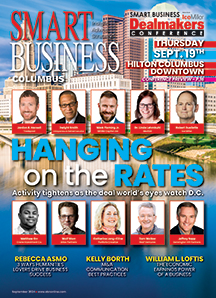In the mid-1980s after David Bishoff joined his father’s company, he got an inkling of how real estate would change.
A couple of young lawyers breaking away from a large law firm leased a small space from E.V. Bishoff Co.
“I’ll never forget — they didn’t want a reception area because they weren’t going to have a receptionist,” says Bishoff, now president of the owner-operator of historic office buildings in Columbus, Cleveland and Pittsburgh. “And I remember asking them how they were going to run their business without a receptionist.”
They had a laptop.
“If you think about it, back in the mid-80s, mobile phones were relatively new, the Internet was just getting going and these guys had figured (it) out,” he says. “They needed half as much space and would do twice as much business.
“I can remember thinking to myself, ‘This is going to change everything,’” Bishoff says.
Operating on a different ROI
EVBCO started as a real estate brokerage company, but 35 years ago moved to the portfolio side — purchasing older, distressed assets with an eye toward holding on to them for generations, Bishoff says.
A different ROI transformed how the company operated.
“The vast majority of the real estate purchasers purchase with an eye toward selling every three to five years,” he says. “What we very quickly came to understand is that everything — from the thinking to the leasing to the management and the capital spend — is entirely different if your view is generational.”
For instance, real estate owners traditionally take one low-pressure steam boiler out and put another in, even though there are more efficient ways to heat high-rises. EVBCO puts in new heating plants, a type of retrofitting that only reaps benefits in 20 or 30 years.
Strong relationships to meet greater needs
Another component of EVBCO’s long-term outlook is stronger relationships.
The real estate industry, as a whole, doesn’t place much value on the relationship side of business, but Bishoff says almost without exception the companies who made it through the recession bucked that trend.
Also, during the recession, Bishoff says companies learned how to do more with fewer people in a smaller space — just like those young lawyers.
The selection of an office was very geographic years ago, he says. Now, it isn’t as focused.
“The location still is one of the primary considerations, but the building itself, the sense of arrival, the infrastructure, the Internet, the bandwidth and all of the things that people used to call an amenity, now it’s an expectation,” Bishoff says.
You might think greater client expectations would make EVBCO’s task more difficult, but Bishoff says it’s actually easier to distinguish yourself — and turn it into a competitive advantage.
Manage by walking around
In order to understand client needs, Bishoff practices what he calls “management by walking around.”
“You’ve got to get out of your office. You’ve got to be in the halls. You’ve got to be stopping into the offices. And you’ve got to be listening with a deep sense of curiosity as to what your clients need, want and expect — because frequently they don’t know,” he says. “If you’re holed up in your office or in your conference rooms all the time, you can’t learn anything.”
When your customers have the opportunity, they’ll tell you what you’re doing well and what you’re doing poorly, Bishoff says. And then by doing something about it, it deepens your relationship further.
For example, EVBCO runs its own technology network so new tenants can get Internet and phones within 24 hours of moving in. And when it weaves things like that into its deliverables, it creates tremendous value for some, Bishoff says.
“If we had elected 20 years ago to maintain the status quo, we most likely would not be in business right now,” he says.
The plant floor or your customer’s office is where the game is won or lost.
“That’s where innovation takes place and that’s where idea generation takes place. And that’s the game right there,” Bishoff says. “It doesn’t have to be complicated.”

Hard-working downtowns
“Ten years ago, we saw some folks moving back into the urban quarters and the question was whether that was a fad or a trend,” Bishoff says.
There’s no longer any doubt.
Bishoff says the downtowns of Pittsburgh, Cleveland and Columbus don’t have as much of a 9-to-5 lifestyle anymore, which changes the office building dynamics.
“All the ground floors used to be one bank after the other in Columbus, and now you can go up and down Gay Street and you see every type of food you could ever imagine. More hotels come in. It’s a dramatically different environment as a result of the housing,” he says.
Each downtown does, however, have a slightly different DNA.
Columbus, which has giants of business who choose to stay in the city, benefitted from its three-legged stool of state government, The Ohio State University and the general business community. This keeps it afloat in good times and bad, Bishoff says.
Cleveland has that to a much smaller extent, so it got hit harder from an economic standpoint.
“What you see happening now, though, in downtown Cleveland is nothing short of remarkable,” he says. “They’ve taken almost 2 million square feet of office space off the market to be redeveloped into housing. When you do something like that, you change everything.”
Grocery stores are popping up and new hotels are coming in. And they woke up to the fact that they’ve got a lake up there to develop on, Bishoff says.
Local talent that loves its city and unleashes its energy is the real game changer.
“The administration in place is always very helpful, and you need them to be pro-business,” he says, “but at the end of the day it’s the individual business owners that get it done.”

